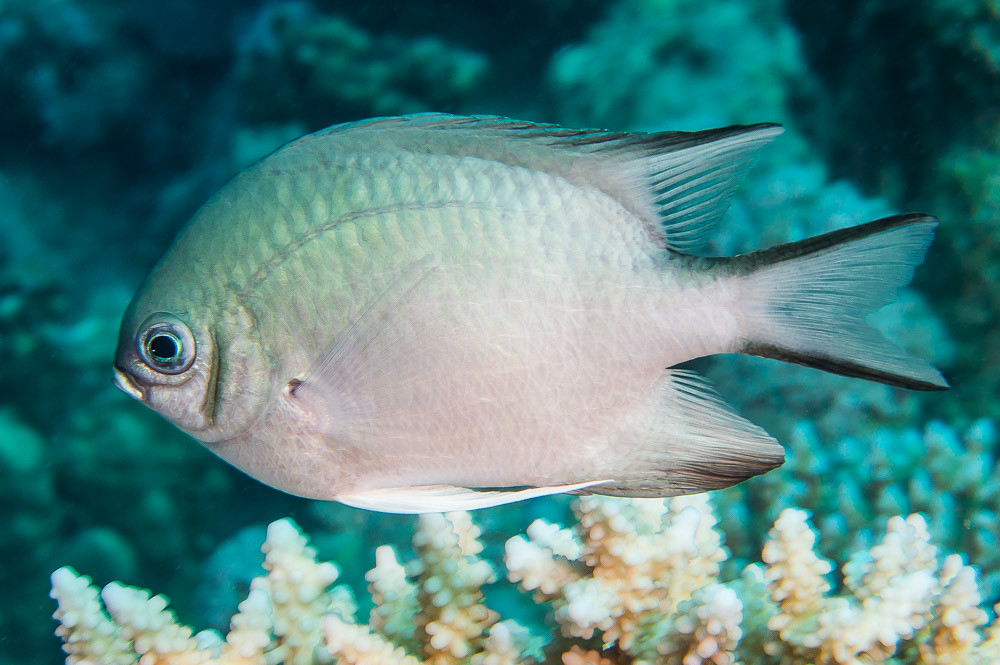Maldives Damselfish, Amblyglyphidodon indicus Allen & Randall 2002
Other Names: Pale Damsel

A Maldives Damselfish, Amblyglyphidodon indicus, at Marsa Alam, Red Sea, Egypt, August 2014. Source: Francois Libert / Flickr. License: CC by Attribution-NonCommercial-ShareAlike
Summary:
A silvery damselfish becoming yellowish-white below, with a greenish head, a broad, vertically elongate greenish streak on each body scale, and a dusky grey margin on the preopercle and upper half of opercle,
The species has translucent to greenish white median fins, a black margin on the upper and lower caudal-fin lobes, pale yellow to white pelvic fins, and a small dark spot on the base of the uppermost pectoral-fin rays.
The species has translucent to greenish white median fins, a black margin on the upper and lower caudal-fin lobes, pale yellow to white pelvic fins, and a small dark spot on the base of the uppermost pectoral-fin rays.
Cite this page as:
Bray, D.J. 2021, Amblyglyphidodon indicus in Fishes of Australia, accessed 27 Jun 2025, https://fishesofaustralia.net.au/Home/species/5621
Maldives Damselfish, Amblyglyphidodon indicus Allen & Randall 2002
More Info
|
Distribution |
Australian territory of Cocos (Keeling) Islands in the eastern Indian Ocean. Elsewhere the species is widespread in the Red Sea and Indian Ocean. Individuals and small groups inhabit shallow areas of lagoons, reef passages, and outer reef slopes at depths of 1-15 m. Occurs around branching Acropora corals on of inshore and outer reefs, using dead branches as nests. |
|
Features |
Dorsal fin VIII,11-13; Anal fin II,13-14; Pectoral fin 17-18; Vertebrae 26; Gill rakers 7-8 + 18-20 = 25-28; Lateral-line tubed scales 15-18. Body depth 1.5-1.7 in SL; teeth incisiform and in a single row; scaled suborbital; predorsal scales extending well before the nostrils, nearly to base of upper lip; |
|
Colour |
Silvery becoming yellowish-white on the belly and lower sides; the back and dorsal part of head is mainly green; with a broad, vertically elongate greenish streak on each body scale; rear edges of preopercle and upper half of opercle are dusky grey; median fins translucent to greenish white, the lower and upper edge of caudal fin narrowly blackish; pelvic fins pale yellow to white; pectoral fins translucent with small dark spot at base of uppermost rays. |
|
Feeding |
Omnivore - feeds on copepods, amphipods, mysids, fish eggs, crustacean larvae, and a small portion of algae. |
|
Etymology |
The specific name is from the Latin indicus (= of India), in reference to the geographical distribution of this species - Indian Ocean and adjacent Red Sea. |
|
Species Citation |
Amblyglyphidodon indicus Allen & Randall 2002. Type locality: Villinglii Island, north Malé Atoll, Maldives. |
|
Author |
Bray, D.J. 2021 |
|
Resources |
Maldives Damselfish, Amblyglyphidodon indicus Allen & Randall 2002
References
Allen, G.R. & Erdmann, M.V. 2012. Reef fishes of the East Indies. Perth : Tropical Reef Research 3 vols, 1260 pp.
Allen, G.R. & Randall, J.E. 2002. A review of the leucogaster species complex of the Indo-Pacific pomacentrid genus Amblyglyphidodon, with descriptions of two new species. aqua, Journal of Ichthyology and Aquatic Biology 5(4): 139-152 See ref online
Rocha, L.A. & Myers, R. 2017. Amblyglyphidodon indicus. The IUCN Red List of Threatened Species 2017: e.T188596A1899477. https://dx.doi.org/10.2305/IUCN.UK.2017-2.RLTS.T188596A1899477.en. Downloaded on 08 July 2021.




